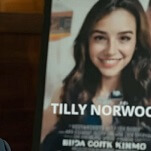Funeral Friday

Congratulations on making it to the end of another week! Unfortunately, these people didn't. Light a candle for Funeral Friday.
On the one hand, it’s easy to shift a little blame Irving Penn’s way for all the awful photography shows you’ve been to, where you’re asked to contemplate how a garbage can “casts a dramatic, portentous shadow over a crack in the sidewalk, signifying encroaching urban ruin” or some such nonsense. After all, Penn was one of the pioneers of recasting the mundane as art, as with his infamous 1975 show at the Museum Of Modern Art, where Penn displayed 14 large prints of cigarette butts and was all, like, “Yeah, think about it.” But on the other hand, Penn was a true trailblazer in the field of portraiture—especially fashion photography, which before he wandered into the position at Vogue in 1943 was all about making sure the model had plenty of props to play with to keep her from getting bored and aimlessly wandering away in the middle of the shoot, and loading up the background with lots of gaudy wallpaper or fake ferns to distract from the drabness of yet another A-line dress. Penn changed all that, preferring a severe setting with clean backgrounds that put the focus on the clothes, or strikingly simple arrangements that nevertheless carried a lot of impact—like his famous debut cover featuring a purse, scarf, gloves, and some oranges and lemons in the shape of a pyramid. (Hey, it was the '40s. A lot easier to blow minds back then.)
Penn eventually moved on to photographing celebrities like Miles Davis, Spencer Tracy, Georgia O’Keefe, and Pablo Picasso, once claiming that he usually got the shot he wanted by photographing them for hours on end until they finally let their guard down. But he wasn’t just about glorifying the bold and beautiful: Penn loved working in far-flung locations, and was equally famous for taking everyone from “New Guinea mud men to San Francisco hippies” out of their natural environment and putting them against a stark studio backdrop in order to truly examine them. At one time he was producing more than 300 fashion pages annually for Vogue while developing his eye for the “real” on the side; his work is housed at the National Portrait Gallery and the Art Institute of Chicago, among other prestigious places. He died this week at the age of 92. Here are a few of his photographs to illustrate the breadth of his work: Pablo Picasso, Kate Moss, and “Cuzco Children, Peru, 1948.”
The official “story by” credit on Coming To America still reads “Eddie Murphy,” but after a seven-year legal battle in the late '80s and early '90s, Paramount Pictures was forced to admit that, okay, it may have come from a much more unlikely source: the writing team of newspaper columnist Art Buchwald and his producing partner, literary agent Alain Bernheim, who sued the studio for $5 million in 1988, alleging that the film was based on a treatment they had sold them five years earlier. Paramount eventually settled for $825,000, and the scandal has quietly faded into movie history, but the effect on Bernheim’s movie career was enormous. Prior to that he had served as an executive producer on the Jack Lemmon/Walter Matthau-starring Buddy Buddy—better known as Billy Wilder’s last film—and produced the Sean Penn/Nicolas Cage dramedy Racing The Moon, but following the lawsuit he only returned to film once more, as a producer on 1998’s mostly forgotten Return To Paradise. But then, movies weren’t really Bernheim’s le bag, anyway: After fleeing France to New York during the German occupation—and briefly returning to fight as part of the Free French forces—Bernheim moved to California and started a career as a talent agent, representing writers like Gore Vidal, Pierre Boulle, and Jean-Paul Sartre, who was probably a total joy to work with. Shortly thereafter he began taking on directors like Jules Dassin, Louis Malle, Nicholas Ray, Joseph Losey, and John Frankenheimer, establishing himself as one of the most trusted men among the old lions of entertainment. But then, he dies this week at the age of 86, and his obituary headlines pretty much all reference Coming To America. C’est la vie.
To a certain raised-on-VHS generation, Mimi Weddell is a familiar face for roles in low-budget horrors—and horror spoofs—Dracula’s Last Rites and Student Bodies, where she played the tightly buttoned school matron, Miss Mumsley. (“Homosexuality is the up-and-coming thing!”) Of course, her acting career didn’t begin until she was well into her 60s, and while she also had a memorable cameo in Woody Allen’s The Purple Rose Of Cairo, and is probably famous to someone for playing the grandmother to token “gay best friend” Stanford on Sex And The City, Weddell is even better known for simply being herself—an eccentric grande dame whose willowy, proudly wrinkled features and chin-held-high elegance has been featured in print ads for Burberry, Nike, Louis Vuitton, and Juicy Couture, and which spurred New York Magazine to name her one of its “Most Beautiful New Yorkers” in 2005. But that’s just the tip of the iceberg, as the 2008 documentary Hats Off revealed: The film about Weddell’s charmed, quirky life chronicled her unlikely second-wind career while focusing on her overwhelming obsession with ostentatious hats, following her as she strolled the streets of Manhattan through various auditions, dance lessons, and visits to the beauty salon. In short, it demonstrated that Weddell was a character in a movie that was far more interesting than any she’d acted in: her own weird, beautiful life. Sadly, that movie finally came to an end this week when Weddell died at the age of 94.







































